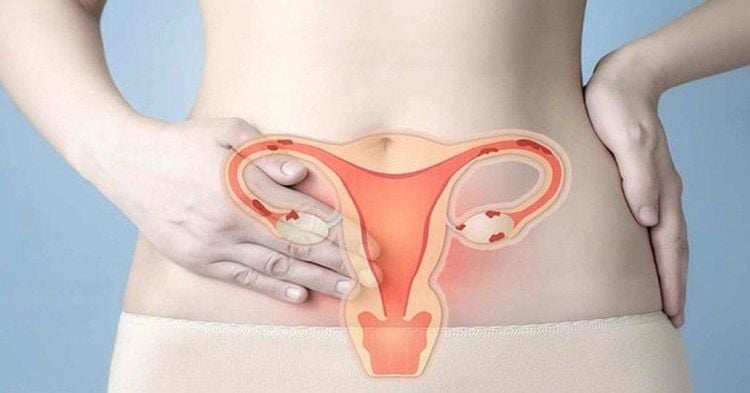This is an automatically translated article.
Endometrial cancer is a common disease in women after menopause. However, a few rare cases of this disease appear in women during the reproductive period. How to treat endometrial cancer in this group of patients while preserving the patient's uterus and ovaries?
1. What is endometrial cancer?
Endometrial cancer, also known as endometrial cancer, is a common disease in developed countries where high-fat diets are common. According to the American Cancer Society, endometrial cancer is the fourth most common cancer among women in the United States, with more than 61,000 cases annually and 11,000 deaths each year.
Endometrial cancer is common in post-menopausal women with an average age of 61 years, however, in the world, nearly 14% of the disease occurs in patients of reproductive age. Most patients of reproductive age with this disease have the desire to preserve the uterus or preserve the ovaries to ensure future reproductive function. Especially women of reproductive age in Vietnam rarely get this disease.

Ung thư niêm mạc tử cung thường gặp ở phụ nữ sau mãn kinh
2. Causes of the formation of endometrial cancer
Currently there is no research to indicate the main cause of the formation of endometrial cancer, experts believe that the change in estrogen levels is related to the development of this disease. In addition, a few factors such as age, women have certain diseases such as diabetes, obesity ...
In addition to the main risk factors, a few of the following factors are also the causes of mucosal cancer formation. uterus:
Patients using Tamoxifen for breast cancer for a long time (usually more than 5 years), this drug has endometrial proliferative effects similar to estrogen Genetic factors Patients who have Prior pelvic radiation therapy Patients with high blood pressure People who have menstruating too early before 12 years of age or menopause late after 55 years of age.
3. How is endometrial cancer diagnosed?
Most people with endometrial cancer have signs of abnormal uterine bleeding such as bleeding after menopause, vaginal discharge is often heavy and has an abnormal color before bleeding occurs.
If the doctor suspects that the patient has endometrial cancer, he or she will order some tests as follows:
Endometrial biopsy: This method has an accuracy of over 90%, the patient Anesthesia is not required and is recommended for irregular bleeding in women over 35 years of age. Endometrial ultrasound: Helps the doctor survey and evaluate the thickness of the uterine lining and detect abnormalities in the uterus if any. MRI scan: To evaluate the growth and metastasis of the tumor as well as the progression of the cancer. A pelvic CT scan helps the doctor check for the spread of the cancer as well as the spread of the cancer, if any.

Đa phần người bệnh đều có dấu hiệu chảy máu tử cung bất thường
4. Endometrial cancer treatment
The standard treatment for endometrial cancer is complete hysterectomy and two adnexa and bilateral pelvic lymph node dissection. Most patients who are diagnosed with this disease are advised by their doctors to remove the uterus, fallopian tubes and ovaries, which means they can no longer bear children.
For patients with endometrial cancer of reproductive age and still wishing to have children, the doctor will conduct uterine-preserving treatment and preserving ovaries. However, conservative treatment does not completely cure this disease, cancer still exists after 6-9 months of treatment or after the patient has completed childbirth.
In addition to hysterectomy for treatment, the doctor may prescribe some additional treatments as follows:
Hormone therapy: Usually used for patients who want to preserve the ovaries and uterus to give birth. After giving birth, the doctor will still recommend that the patient undergo surgery to prevent the disease from progressing.
Chemotherapy: Using drugs to kill cancer cells by intravenous injection according to treatment cycles. This cycle is repeated several times and there is a period of rest between each time. Chemotherapy has a few side effects such as anemia, hair loss, diarrhea, and fatigue. However, these symptoms will disappear after the treatment is finished.
Radiation: Using a strong beam to kill cancer cells, the aim here is to shrink the tumor before surgery, making it easier to remove the tumor. The side effects of radiation therapy are similar to those of chemotherapy and will also go away after the treatment is finished.

Phương pháp điều trị ung thư niêm mạc tử cung tùy thuộc vào tình trạng bệnh cụ thể
Vinmec International General Hospital with modern civilized disease prevention system, comprehensive care, meals, rest, exercise, health education, each room is equipped with the same amenities 5-star hotel apartment, patient information is confidential.
Vinmec's Hybird operating room is the most modern operating room system in the world today, integrating operating room and advanced imaging equipment (CT scan, MRI, ultrasound...) to help reduce time Surgery time and bring the best surgical effect to the patient, minimize the risk of hospital infections, complications during laparoscopic surgery to help patients less trauma, recover quickly, leave very scars. Small size and especially safety is very high compared to conventional open surgery.
When performing a laparoscopic total hysterectomy at Vinmec, patients can experience the most advanced techniques such as: full HD laparoscopic surgery system, with a tissue cutter when the tumor is too large, need to push the uterus for surgery, there are tools to seal the vagina
In general anesthesia, Vinmec adheres to anesthesia protocols, anesthesia safety guidelines, anesthesia checklists for 100% of surgeries techniques to minimize incidents and unwanted effects.
If you have a need for consultation and examination at Vinmec Hospitals under the national health system, please book an appointment on the website for service.













